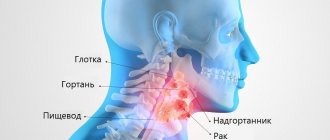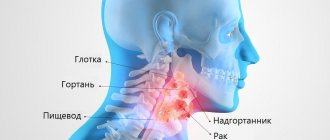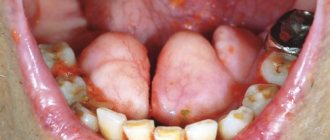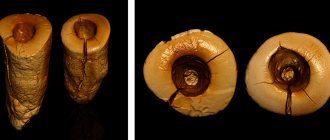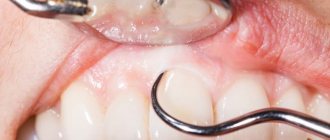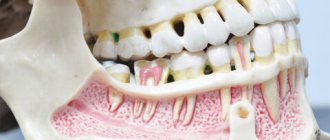The lymphatic system is an integral part of the vascular system of the human body. It performs a number of functions, participates in metabolic processes, and works as a cleansing and protective mechanism. The system of lymph nodes and ducts transports proteins and tissue fluid from the interstitial space into the blood vessels, and transfers fats from the small intestine there. In the space of the lymphatic system, fluid circulates - lymph.
Symptoms of pathology
The fact that a person has “caught” a lymph node usually means its increase in size. Occasionally it hurts, and the skin over it becomes red. In this case, doctors talk about lymphadenitis.
An important point is the mobility of the lymph node. Normally, it easily moves a short distance. If the lymph node is motionless and enlarged, a doctor’s consultation is urgently needed.
Not all lymph nodes can be examined independently. When magnified, they can be felt on the neck, under the armpits, and in the groin area. It is important where the inflamed area is located. If a lymph node in the neck has caught a cold, how to treat it will differ from the situation when the groin or axillary area is affected. By localization, one can judge a preliminary diagnosis, since lymphadenopathy is often only a symptom of the underlying disease.
Nodule on the neck or why you need to know the cause of lymphadenitis
A nodule on the neck or why you need to know the cause of lymphadenitis.
Many of us take swollen lymph nodes rather lightly, believing that this trouble will go away on its own. There is, of course, a successful outcome, and the lymph glands are restored to their normal size on their own. But most often, the enlarged nodes begin to hurt, the skin over them turns red, and the temperature in this part of the body rises. This is how lymphadenitis develops - inflammation of the lymph nodes.
We asked general practitioner Dmitry Nikolaevich ZABASHT to tell us more about this disease.
— What is the lymphatic system and what is its role in the body?
— The lymphatic system consists of a network of small vessels that collect excess fluid (lymph), foreign particles and other unnecessary substances from body tissues and cells. This is a kind of drainage system (washing and cleaning). Small lymphatic vessels, merging with each other and flowing into larger ones, pass through the lymph nodes. Lymph nodes are unique filters that trap and neutralize microbes and other toxic substances that have entered the body. Next, the lymphatic vessels, connecting into two large ducts, flow into the blood veins.
— Why do the lymph nodes become inflamed?
— If a large number of microbes enter the lymph node, then it ceases to cope with their neutralization and begins to “scream” for help, that is, to become inflamed. This means that there is some kind of infection in the body.
— Where do lymph nodes usually enlarge?
— The lymph node is a barrier that prevents the infection from spreading further throughout the body. The lymphatic system begins to fight microbes already in its vessels, and therefore very often you can see a pink thin path running from the source of infection to the inflamed lymph node. The cause of lymphadenitis can be a crack in the skin, a splinter, a scratch. A slight suppuration causes mild pain, and a person usually doesn't pay attention to it. But then suddenly it begins to hurt in the groin or armpit areas, swelling appears, the lymph nodes enlarge and become painful to the touch. This means that local immunity could not cope with the infection and it spread further. Each lymph node is responsible for its own specific area in the body. And if the source of infection is, for example, on the leg, then the popliteal node first becomes inflamed. When the protection weakens, the microbes move to the inguinal node. Any infectious process can be accompanied by lymphadenitis. Depending on the location of the microbes, different lymph nodes become inflamed. For example, submandibular lymphadenitis is a sign of caries, tonsillitis (inflammation of the tonsils) or gingivitis (inflammation of the gums). If several lymph nodes become inflamed at once, this means that the infection is too advanced. With painless enlargement of a group of lymph nodes, a tumor process cannot be excluded.
— Therefore, with lymphadenitis, it is not the lymph nodes that need to be treated, but the infection should be fought?
- Absolutely right. If the root cause is removed, the lymphadenitis itself will subside, and the nodes will return to their original appearance (with the exception of their suppuration, which requires more serious attention). Sometimes it is enough to disinfect the wound several times a day to get rid of lymphadenitis. Some diseases (for example, sore throat) are accompanied by inflammation of the lymph nodes, which are restored as the disease subsides. Therefore, you should not rush to discharge, even if the temperature has returned to normal and all the symptoms of the disease have passed, but the lymph nodes are still enlarged and painful. This suggests that the recovery process in the body is not yet complete. And if you neglect this signal, complications cannot be avoided.
— What mistakes do patients make when trying to cope with lymphadenitis on their own?
— You cannot self-medicate for lymphadenitis. It is unacceptable to warm up the nodes or apply ointments to them. If the lymph nodes are enlarged and painful, you should immediately consult a doctor - a therapist or surgeon. Depending on the disease, treatment will be prescribed.
— In what cases do lymph nodes have to be removed?
— Lymph nodes are removed during tumor processes, since they accumulate unneutralized malignant cells, which can spread throughout the body and cause secondary tumors (metastases). Enlarged lymph nodes due to tumors are not lymphadenitis, but outwardly they appear the same.
Daria PONOMAREVA.
By the way, cat scratches are not harmless.
Enlarged lymph nodes can occur from a simple cat scratch if the cat has given you an infection. An infected cat is no different from a healthy one. Cats themselves do not get sick, but they infect humans by scratching, biting, and even licking them. A few days after the injury, the victim’s lymph nodes, which are located in the immediate vicinity of the bite, begin to enlarge, the temperature may rise, and a rash often appears. If the state of the immune system is good, then the disease will go away on its own, causing a lot of trouble. To avoid them, it is advisable to take immediate action. Treat the area of scratches and bites with a 2% solution of hydrogen peroxide, and then with iodine or alcohol. You should not self-medicate; it is better to immediately consult an infectious disease doctor. You may have to add antibiotics or hormonal drugs. Positive results can only be achieved by fighting the underlying disease, which is the root cause of enlarged lymph glands. Preventive measures for cat scratch disease are simple: wash the cat using disinfectants (preparations to kill parasites) and try not to let playtime get too bad with a pet to scratches and bites.
What diseases does it occur in?
First, you need to look for inflammation near the affected lymph node. Usually bacteria or viruses enter it from a nearby organ.
Diseases in which the cervical lymph node becomes inflamed:
- acute respiratory infections and acute respiratory viral infections;
- tonsillitis (acute or chronic);
- dental diseases (focus of infection in the mouth).
Enlarged inguinal lymph nodes are often associated with sexually transmitted diseases, including herpes infection. Axillary units are inflamed with hidradenitis - a pathology of the sweat glands.
Sometimes inflammation of the lymph node occurs against the background of a general weakened state of the body. This is observed in malignant neoplasms, blood pathologies, HIV infection and viral hepatitis B.
In a chronic specific inflammatory disease, an enlarged lymph node is a normal variant. This is a reaction to the underlying pathological process and does not require treatment.
Enlargement of more than one lymph node often indicates infection. This is how tuberculosis, syphilis, and tularemia manifest themselves. Inflammation of a large number of lymph nodes indicates a serious infectious process - HIV, toxoplasmosis, brucellosis, CMV, mononucleosis and others. This requires urgent consultation with an infectious disease specialist.
What are lymph nodes in the neck
Lymph nodes are bean-shaped and ribbon-shaped formations of lymphatic tissue. In the neck, the nodes are located in clusters of up to 10 pieces, near blood vessels, mainly large veins. Their surface is represented by connective tissue, which forms a capsule. Trabeculae extend from it into the node, also connective tissue - the so-called supporting structures, similar to beams.
The internal structural basis of the node is a stroma of reticular connective tissue with process cells. These cells, together with the reticular fibers they form, form a three-dimensional network. The structure of the stroma also includes phagocytic cells of several varieties. The inner part of the ganglion is called the medulla. Closer to the plane of the capsule is the cortex with a superficial part and a zone of deep cortex.
The accumulation of lymphoid tissue inside the space of the node forms follicles - lymph nodes located closer to the capsule. The deep cortex contains a large number of lymphocytes with a dense and uniform arrangement. The lymph node, in fact, is a barrier to retain infection, pathologically altered cells, and tumors. It contains the formation of lymphocytes - protective cells that destroy foreign elements. Cervical lymph nodes are divided into:
- anterior cervical
- posterior cervical;
- occipital;
- chin;
- submandibular nodes.
In a normal state, a healthy person often cannot feel them, since they are small in size, soft and elastic, and quite mobile under the skin.
Diagnostics
The first thing to do if a lymph node is inflamed is to visit a doctor. He will inspect not only the disturbing group, but also the neighboring ones. It’s easy to miss this on your own, but detecting such changes will help make a diagnosis. If several lymph nodes are affected, the mucous membranes and skin are also examined for rashes.
The phased examination includes:
- General and biochemical blood test, general urine test.
- Testing for hepatitis B and C, HIV, syphilis.
- Fluorography, if necessary, an x-ray of the lungs.
- Ultrasound of the abdominal organs.
- Ultrasound of lymph nodes.
- Biopsy of lymph node tissue.
Based on the research results, a diagnosis is made and treatment tactics are formulated.
Treatment
If a patient has a cold lymph node, treatment is selected taking into account the underlying disease. The treatment regimen depends on the type of pathogen.
Treatment methods:
- Antibiotic therapy - for bacterial infection.
- Antiretroviral drugs - for HIV and AIDS.
- Antiherpetic drugs - for herpetic infection.
- Antimycotics - for fungal infections.
- Bed rest and plenty of warm drinks - for mild ARVI.
Self-medication is dangerous not only due to the incorrect selection of drugs, but also the development of the underlying disease. It is better to detect it early and treat it than to waste time and money on inappropriate medications.
Read also: Dry paroxysmal cough
Dear patients! Remember that only a qualified doctor can make an accurate diagnosis, determine the causes and nature of the disease, and prescribe effective treatment. You can make an appointment with our specialists or call a doctor at home by calling 8-(4822)-33-00-33
Be healthy and happy!
Symptoms of a neck tumor - diagnosis and treatment
In medicine, the term “neck tumors” refers to various malignant formations of various structures, characterized by localization in the pharynx, larynx and trachea. That is, this term in the standard interpretation does not include neoplasms in the central nervous system, eyes, nervous, endocrine and lymphatic systems, despite the fact that they can also develop in the cervical region. The symptoms of a neck tumor are largely determined by the nature of the factors that caused them.
Approximately 80% of neoplasms of the neck and head are caused by the use of tobacco and alcohol products. Other risk factors include exposure to radiation, HPV, work in hazardous industries, and the Epstein-Barr virus. Symptoms of head and neck tumors depend on what type of cancer cells they are caused by. Most often, cervical tumors are caused by squamous cell carcinoma. The standard measure to confirm the diagnosis is a biopsy. For a correct diagnosis, not only symptomatic manifestations and the results of examination by a doctor are important, but also the totality of data from a specialized medical examination.
Screening for cervical malignancies is not routinely performed in the general population. However, regular screening of populations most at risk may be helpful. In many cases, cervical tumors are treatable if diagnosed early. For this reason, if you notice symptoms of a neck tumor, you should consult a doctor to clarify the situation as quickly as possible. A delayed reaction to signs of a tumor or ignoring them can lead to a decrease in the effectiveness of treatment.
A number of types of neck tumors usually begin with seemingly harmless manifestations. These may include swelling of the lymph nodes in the neck, sore throat, or hoarseness. However, with laryngeal cancer, these painful conditions can intensify and become chronic. There may be lumps or ulcerations in the larynx or neck that do not go away or heal. Symptoms of a neck tumor may also include problems swallowing, which can be painful. Signs of a neck tumor may also include neck pain, bleeding and bad breath, weight loss and other symptoms. Next, the symptoms of various types of cervical tumors are discussed in detail.
